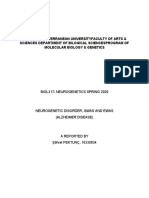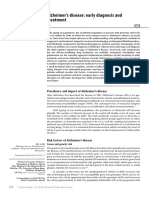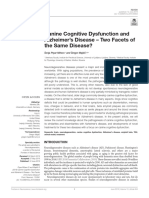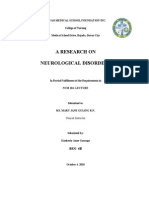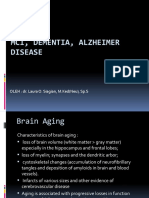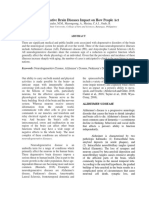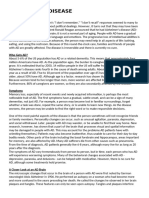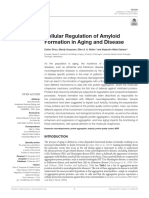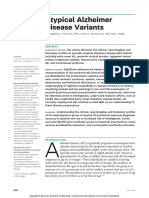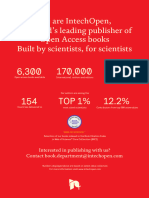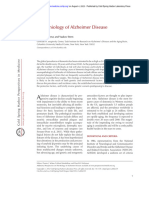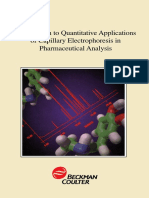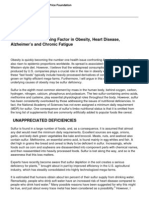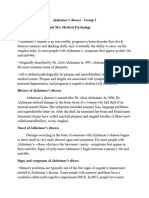Alzheimer's Disease: A Threat To Mankind: Poorti Pandey, Mritunjai Singh, I. S. Gambhir
Alzheimer's Disease: A Threat To Mankind: Poorti Pandey, Mritunjai Singh, I. S. Gambhir
Uploaded by
Wafa BadullaCopyright:
Available Formats
Alzheimer's Disease: A Threat To Mankind: Poorti Pandey, Mritunjai Singh, I. S. Gambhir
Alzheimer's Disease: A Threat To Mankind: Poorti Pandey, Mritunjai Singh, I. S. Gambhir
Uploaded by
Wafa BadullaOriginal Title
Copyright
Available Formats
Share this document
Did you find this document useful?
Is this content inappropriate?
Copyright:
Available Formats
Alzheimer's Disease: A Threat To Mankind: Poorti Pandey, Mritunjai Singh, I. S. Gambhir
Alzheimer's Disease: A Threat To Mankind: Poorti Pandey, Mritunjai Singh, I. S. Gambhir
Uploaded by
Wafa BadullaCopyright:
Available Formats
Journal of Stress Physiology & Biochemistry, Vol. 7 No. 4 2011, pp.
15-30 ISSN 1997-0838
Original Text Copyright © 2011 by Pandey, Singh, Gambhir
REVIEW
Alzheimer’s disease: A Threat to mankind
Poorti Pandey, Mritunjai Singh, I. S. Gambhir
Department of Medicine, Institute of Medical Sciences, Banaras Hindu University, Varanasi
(U.P.) India 221 005
E-mail: i_gambhir@rediffmail.com
Received August 10, 2011
Alzheimer’s disease (AD) is neurodegenerative disorder common among elderly involving deficits in
memory and cognition. There has been a long history of research and medical practice in AD
worldwide, during which different facts came into light. During recent decades with new technologies
being integrated, progress has been made in finding new genes responsible for AD, but diagnosis and
treatment. In this review we will focus on molecular, genetic and other evidence underlying the known
AD pathology.
Key words: Alzheimer /Cholinesterase / Dementia/ Neuritic plaques/ neurofibrillary tangles.
JOURNAL OF STRESS PHYSIOLOGY & BIOCHEMISTRY Vol. 7 No. 4 2011
16 Alzheimer’s disease...
REVIEW
Alzheimer’s disease: A Threat to mankind
Poorti Pandey, Mritunjai Singh, I. S. Gambhir
Department of Medicine, Institute of Medical Sciences, Banaras Hindu University, Varanasi
(U.P.) India 221 005
E-mail: i_gambhir@rediffmail.com
Received August 10, 2011
Alzheimer’s disease (AD) is neurodegenerative disorder common among elderly involving deficits in
memory and cognition. There has been a long history of research and medical practice in AD
worldwide, during which different facts came into light. During recent decades with new technologies
being integrated, progress has been made in finding new genes responsible for AD, but diagnosis and
treatment. In this review we will focus on molecular, genetic and other evidence underlying the known
AD pathology.
Key words: Alzheimer /Cholinesterase / Dementia/ Neuritic plaques/ neurofibrillary tangles.
Dementia is a serious loss of cognitive ability, is et al, 2003). The risk of AD rises exponentially with
far more common in the geriatric population, it may age, such that up to 47% of individuals over the age
occur before the age of 65 (Fadil et al, 2009). of 80 develop AD. More women than men have
Dementia is not merely a problem of memory. It Alzheimer’s disease and other dementias. Almost
reduces the ability to learn, reason, retain or recall two-thirds of all Americans living with Alzheimer’s
past experience and there is also loss of patterns of are women. (Plassman et al, 2007) Based on
thoughts, feelings and activities. It is caused by estimates from ADAMS, 16 percent of women aged
various diseases that result in damaged brain cells, 71 and older have Alzheimer’s disease or other
or connections between brain cells as listed in table dementia compared with 11 percent of men.
1. For diagnosing dementia, Diagnostic and (Seshadri et al, 1997) According to report on AD
Statistical Manual of Mental Disorders, Fourth between 2000-2008 deaths due to AD increased
Edition (DSM-IV) is preferred. (American 66% while previously reported number one cause of
Psychiatric Association, 1994) death, heart disease decreased 13 %. Based on the
AD is an age-related neurodegenerative disease age of onset & heriditary feature AD is of following
& affect upto 10% of elderly above 60 years (Frank types:-
JOURNAL OF STRESS PHYSIOLOGY & BIOCHEMISTRY Vol. 7 No. 4 2011
Pandey et al
17
• Early-onset Alzheimer's: This is a rare form inherited. In affected families, members of at least
(less than 10% cases) of AD in which people are two generations have had AD. FAD is extremely
diagnosed before age of 65. (Alzheimer’s rare, accounting for less than 1% of all cases of AD.
Association, 2006) It has a much earlier onset (often in the 40s) (Scott
• Late-onset Alzheimer's: This is the most et al, 2008).
common form of AD, accounting for about 90% of On average, AD patients live about 8 years after
cases and usually occurring after age 65. Late-onset initial diagnosis, although the disease can last for as
Alzheimer's disease strikes almost half of all people long as 20 years. The areas of the brain that control
over the age of 85 and may or may not be memory and thinking skills are affected first but, as
hereditary. Late-onset dementia is also called the disease progresses, neurons in other regions of
sporadic AD. (Scott et al, 2008) the brain are also affected. Eventually, the patient
with AD will need complete care, adding further
• Familial Alzheimer's disease (FAD): This
emotional, physical, and financial costs to the family
is a form of AD that is known to be entirely
(Vitaliano et al, 2003).
Amyloid Cascade hypothesis
Missense mutations in APP, PS1or PS2 genes
▼
Increased Aβ42 production & accumulation
▼
Aβ42 oligomerization & deposition as diffused plaques
▼
Subtle effects of Aβ oligomers on synapses
▼
Microglial & astrocytic Activation
(complement factors, cytokines etc)
▼
Progressive synaptic & neuritic injury
▼
Altered neuronal ionic homeostasis :
Oxidative injury
▼
Altered kinase/phosphatase activities ►Tangles
▼
Widespread neuronal / neuritic dysfunction & cell death
with transmitter deficits
▼
Dementia
Flowdiagram 1 The sequence of pathogenic events leading to AD proposed by the amyloid cascade
hypothesis. The curved arrow indicates that Aβ oligomers may directly injure the synapses
and neurites of brain neurons, in addition to activating microglia and astrocytes. (Adopted
from Hardy, et al,2002 )
JOURNAL OF STRESS PHYSIOLOGY & BIOCHEMISTRY Vol. 7 No. 4 2011
18 Alzheimer’s disease...
Table 1: Common Types of Dementia and Their Typical Characteristics
JOURNAL OF STRESS PHYSIOLOGY & BIOCHEMISTRY Vol. 7 No. 4 2011
Pandey et al
19
Neurofibrillary tangles and senile plaques are the involves a series of brain scans, cognitive
two characteristic hallmarks of disease, observed in assessment and laboratory tests as mentioned in
alzheimer’s brain (Scott et al, 2008; Tiraboschi et al, table 2. These help identify physical and cognitive
2004). Both amyloid plaques and neurofibrillary changes associated with Alzheimer’s disease, and
tangles can be visalised by microscopy in brains of rule out other conditions, causing similar symptoms.
those afflicted by AD. Plaques are dense, mostly
Molecular and Genetic aspect of AD
insoluble deposits of amyloid-beta peptide and
Amyloid precursor protein (APP) and Neuritic
cellular material (dystrophic axons & dendrites)
Plaques
primarily. Activated microglia & reactive astrocytes
outside and around neurons as well as α-synuclein, APP is an integral membrane protein as shown
ubiquitin, apolipoprotein E, presenilins and alpha in figure 1, expressed in many tissues and
antichymotrypsin,are also observed (Yankner, 1991; concentrated in the synapses of neurons. In humans,
Hardy, 1991; Joachim, 1992 Selkoe, 1994; Dewji, the gene for APP is located on chromosome 21
1996; Wang, 1991; Kudo, 1994). A recent study has (Table 3) and contains at least 18 exons in 240
shown that Lewy bodies are present in the brains of kilobases (Thomas et al, 2007) Several alternative
about 60% of AD cases (Hamilton, 2000). Tangles splicing isoforms of APP have been observed in
(neurofibrillary tangles) are aggregates of the humans, ranging in length from 695 to 770 amino
microtubule-associated protein tau which has acids with certain isoforms preferentially expressed
become hyperphosphorylated and accumulate inside in neurons; Mutations in this gene cause excessive
the cells themselves. Although many older cleavage by the β- and γ-secretase enzymes, instead
individuals develop some plaques and tangles as a of normal cleavage by the α-secretase enzyme
consequence of aging, the brains of AD patients (shown in flowdiagram 2). The result is increased
have a greater number of them in specific brain production of toxic β-amyloid fragments a 39- to 42-
regions such as the temporal lobe. amino acid peptide, which are converted into
insoluble aggregates that form senile plaques in
Diagnosis
brain tissue associated with Alzheimer's disease
Diagnosis of AD is not a single step process &
Figure 1: Structure of Amyloid precursor protein.
Table 2: Various methods of diagnosis
JOURNAL OF STRESS PHYSIOLOGY & BIOCHEMISTRY Vol. 7 No. 4 2011
20 Alzheimer’s disease...
Diagnostic tool Types References
Brain scan Computed tomography (CT)/Magnetic resonance imaging (MRI)/ Abella 2009;
Single photon emission computed tomography (SPECT)/ Positron Dougall, 2004
emission tomography (PET)
Cognitive Abbreviated mental test score (AMTS)/Mini mental state Teng et al 1987 ;
assessment examination (MMSE)/Modified Mini-Mental State Examination Teng et al 1994;
(3MS)/Cognitive Abilities Screening Instrument (CASI)/clock Royall et al 1998
drawing test.
Laboratory test Vitamin B12, folic acid, thyroid-stimulating hormone (TSH), C- www.alzforum.org
reactive protein, full blood count, electrolytes, calcium, renal
function, and liver enzymes etc. to rule out treatable causes.
Table 3: Various genes responsible in AD pathology are summarized below:
Gene Chromosomal Pathological Significance References
Location
APP 21q21.2 Senile Plaques formation Schellenberg (1995)
PSI 14q24.3 Enhance γ secretase activity Hardy (2001);
Nishimura et al,(1999)
PSII 1q31.42 Enhance γ secretase activity Hardy (2001);
Nishimura et al, (1999)
Tau 17q21.1 Neurofibrillary tangles formation Iqbal et al (1989)
ApoE 19q13.2 Not clear Roses (1997)
Flowdiagram 2: Cascade of APP cleavage in normal (left) and diseased state (right)
JOURNAL OF STRESS PHYSIOLOGY & BIOCHEMISTRY Vol. 7 No. 4 2011
Pandey et al
21
Presenilin tangles are major hallmarks of AD (Flament et al,
1989).
Two other genes that cause familial early-onset
Alzheimer’s disease are presenilin-1, located on Until recently, only total tau protein (t-tau) as a
chromosome 14 (Shellenberg et al, 1992; Hardy marker of neuronal damage was detectable in
2001), and presenilin-2, located on chromosome 1 cerebrospinal fluid (CSF). Elevated levels of CSF t-
(Nishimura et al, 1999) (Table 3). Presenilins are a tau have been observed in patients with AD, even in
family of related multi-pass transmembrane proteins those with mild dementia, compared with healthy
that function as a part of the gamma-secretase elderly controls. However, CSF t-tau levels are of
intramembrane protease complex and mutations lead limited value in the differential diagnosis of AD,
to excessive cleavage by the γ- secretase enzyme. because they can be increased in other dementia
Aβ 42 is more likely to aggregate to form plaques in disorders. Therefore, it appears likely that t-tau
the brain than Aβ 40. Presenilin mutations lead to an levels reflect neuronal degeneration rather than AD-
increase in the ratio of Aβ 42 produced compared to specific pathophysiology. Detection of
Aβ 40, although the total quantity of Aβ produced phosphorylated tau (p-tau) protein in the CSF
remains constant. (Citron et al,1997) therefore may provide a useful biomarker.
Tau and Neurofibrillary Tangles Apolipoprotein
Tau protein located on chromosome 17 (Table The protein, ApoE, is mapped to chromosome
3), are known to stabilize microtubules. They are 19, (Table 3) and is known play fundamental role in
abundant in neurons in the central nervous system maintenance and repair of neurons (Mahley, 1998;
and are less common elsewhere. Six tau isoforms Mahley et al, 2000). The APOE gene consists of
exist in brain tissue, and they are distinguished by four exons and three introns, totaling 3597 base
their number of binding domains. Three isoforms pairs. ApoE is polymorphic with three major
have three binding domains and the other three have isoforms, ApoE2 (5-10%), ApoE3 (60-70%), ApoE4
four binding domains. The binding domains are (15-20%), which translate into three alleles of the
located in the carboxy-terminus of the protein and gene: Higher frequency of the ApoE4 allele is found
are positively-charged (allowing it to bind to the in patients with AD than in the general population
negatively-charged microtubule). The isoforms with (Corder et al, 1993). However, the pathogenetic
four binding domains are better at stabilizing mechanism of ApoE4 in AD is unknown, there are
microtubules than those with three binding domains. few proposed mode of action . ApoE4 is known to
The isoforms are a result of alternative splicing in inhibit neurite outgrowth, (Nathan et al, 1994;
exons 2, 3, and 10 of the tau gene. Bellosta et al, 1995) disrupt neuronal cytoskeleton
(Nathan et al, 1994; Bellosta et al, 1995; Holtzman
Hyperphosphorylation of the tau protein (tau
et al, 1995), stimulate tau phosphorylation (Tesseur
inclusions, p-Tau) can result in the self-assembly of
et al, 2000; Huang et al, 2001) & causes
tangles of paired helical filaments and straight
neurodegeneration (Buttini et al, 1999). In vitro
filaments, which are involved in the pathogenesis of
studies have shown that ApoE3 binds to the
AD and other tauopathies (Kosik, 1994). Abnormal
microtubule associated protein tau with high avidity,
hyperphosphorylation of the microtubule- associated
whereas ApoE4 does not bind tau, suggesting that
tau protein and its incorporation into neurofibrillary
JOURNAL OF STRESS PHYSIOLOGY & BIOCHEMISTRY Vol. 7 No. 4 2011
22 Alzheimer’s disease...
ApoE3, but not ApoE4, by binding to tau, slows the 4. ADAM 10 present on chromosome 15
degree of tau phosphorylation and self assembly into (15q22.1) is an α- secretase, cleaves APP in a way
paired helical filaments (Strittmatter al, 1994). It has leading to P3 formation thus ceases the Aβ peptide
also been suggested that intraneuronal ApoE, by formation by β- secretase (Kim et al, 2009).
interaction with tau protein, may influence the These 4 genes mentioned above are responsible
neuronal pathology in AD, from early in the disease for late onset of AD; mutation in any of them will
(Han et al, 1994). increase the risk of AD.
These allelic forms differ from each other only
Other Risk Factors
by amino acid substitutions at positions 112 and
In addition to aging & genetic factor there are
158. E3 has Cys-112 and Arg-158 whereas E2 has
many other risk factors like head injury (traumatic
Cys at both positions and E4 has Arg (Mahley et al,
brain injury) (Lye et al, 2000), strokes &
1999). People who inherit one or two APOE ε4
ministrokes, unhealthy habits (Anstey et al, 2007),
alleles tend to develop AD at an earlier age than
high cholesterol (Sjogren et al, 2005), low level of
those who do not have any. APOE ε4 is called a
formal education & low social-economic status.
risk-factor allele because it increases a person’s risk
Cardiovascular and cerebrovascular and vascular
of developing AD with exceptions.
risk factors (Korf et al, 2005; Decarli, 2004)
Besides these genes with technological
cardiovascular disease and subgroups of patients
advancement in genetic analysis over last few years
with peripherial arterial disease (Newman et al,
lead to the discovery of new genes associated with
2005) and elevated plasma total homocysteine
late onset of AD. With the help of genome wide
concentrations and low serum folate concentrations
association study (GWAS) it is easy to screen
(Ravaglia et al, 2005). Zinc metabolism
several genes at a time which led to the discovery of
(Mocchegiani et al, 2005), loss of microglial cell
novel genes, few among them are
function (Streit, 2005); and decreased melatonin
1. CLU gene present on chromosome 8
(Srinivasan et al, 2005). Environmental factors, such
(8p21), which is another apolipoprotein , like Apo
as heavy metal exposure (Treiber, 2005), have been
E, may play a role in clearing β- amyloid out of
investigated for many years.
brain (Harold et al, 2009).
Nutrition and lifestyle factors, such as midlife
2. PICALM (phosphatidyl inositol binding
obesity (Kivipelto et al, 2005), lack of exercise
clathrin assembly protein), present on chromosome (Kiraly et al, 2005) and watching too much
11 (11q14) which seems to be involved in recycling television in middle-adulthood (Lindstrom et al,
of cell membrane protein at synapses (Harold et al, 2005), have been associated with an increased risk
2009). for AD. Even a man’s height has been associated
3. CR1 (complement receptor 1) present on with risk. Researchers have reported that short men
chromosome 1 (1q32) is an immunoprotein, are at increased risk (presumably due to its
responsible for inflammatory response may be association with childhood nutrition and other risk
involved in clearing β- amyloid from brain ( Jun et factors) for dementia (Beeri et al, 2005).
al, 2010). Down’s syndrome results in trisomy of
chromosome 21. Those suffering from this disease
JOURNAL OF STRESS PHYSIOLOGY & BIOCHEMISTRY Vol. 7 No. 4 2011
Pandey et al
23
& survive beyond 40s are at high risk of developing higher than body can get rid of them thus leading to
abnormal brain changes that characterize AD but not toxic effect on every cell in body, leading to aging &
all of them develop dementia (Lott et al, 2005; several brain pathologies.
Nistor et al, 2007), this led to the discovery of the Oxidative and Nitrosylative Damage Hypothesis
APP gene on chromosome 21 (Goldgaber et al, states that, reactive oxygen species (ROS) and
1987). People with Down syndrome are particularly reactive nitrogen species (RNS) are important in the
at risk for a form of early onset Alzheimer's disease initiation and promotion of neurodegeneration in the
(Alzheimer’s Association, 2006). brains of patients with AD (Anderton B). Some of
Diabetes mellitus (DM) and AD are the two these free radicals are released during inflammatory
most devastating health problems in elderly. reactions, whereas others are formed during normal
Diabetes is associated with cognitive decline and oxidative metabolism and auto-oxidation of certain
dementia. Indeed, individuals with diabetes are neurotransmitters and by β-amyloid. Thus, the role
nearly 1.5 times more likely to experience cognitive of free radicals in the pathogenesis of AD should be
decline and frank dementia than individuals without considered, at least in part, independent of
diabetes (Cukierman et al, 2005). Multiple possible inflammatory reactions. Clinical studies showing the
mechanisms for this association have been beneficial effects of high dose antioxidants such as
proposed, including direct effects of hyperglycemia, vitamin E (Sano et al, 1997) and NADH
insulin resistance, and insulin- induced amyloid-β (Birkmayer, 1996) in the treatment of AD support
peptide (Aβ) amyloidosis in the brain as well as the role of free radicals in progressive degeneration
indirect ischemic effects of DM-promoted of neurons.
cerebrovascular disease (Biessels et al, 2005).
Treatment
Diabetes increases the risk of Alzheimer disease and
There are currently no means for reversing the
vascular dementia. The risk is stronger when
pathological processes of AD. Normal physiology of
diabetes occurs at mid-life than in late life (Xu et al,
brain deals in transmitting messages (impulses)
2009).
along nerve fibre by electrical mechanism. This
Oxidative stress
electricity is insufficient to cross junction, thus
The search for risk factors is diverse and impulse release neurotransmitter acetylcholine
ongoing, and includes a variety of cellular processes (ACh) which diffuses across junction to stimulate
such as oxidative stress, disturbed protein next cell, after purpose is solved these are eliminated
metabolism, and their interaction (Calabrese et al, by cholinesterase, otherwise disastrous stimulating
2003). Oxidative stress is believed to be a critical downstream cell. In diseased state, as nerve endings
factor in normal aging (Sohal et al, 1996) and become sick so the concentration of ACh released
neurodegenerative diseases such as Parkinson’s get progressively smaller, hence unable to transmit
disease and amyotrophic lateral sclerosis. Oxidative message across junction Thus cholinesterase
stress is a threatening situation when oxidants inhibitors are used to prevent cholinesterase from
overwhelm antioxidants defenses, or when small destructing ACh. Few drugs in this category are
molecules like reactive oxygen species (ROS) & Galantamine, Rivastigamine and Donepezil (Doody
reactive nitrogen species (RNS) accumulate at a rate et al, 2001)
JOURNAL OF STRESS PHYSIOLOGY & BIOCHEMISTRY Vol. 7 No. 4 2011
24 Alzheimer’s disease...
Another is Memantine (NMDA receptor treatable syndrome. Journal of Medicine,
antagonist) responsible for blocking glutamate 273, 117-126.
receptors (involved in recycling of glutamate Alzheimer’s Association. (2006) Early-Onset
another neurotransmitter) (Reisberg et al, 2003). Dementia: A National Challenge, A Future
Few others may include secretase inhibitors, or one Crisis. Alzheimer’s Association.
interacting with Aβ thus preventing its Washington, D.C.
accumulation. Thus therapy stresses on preserving
American Psychiatric Association (1994)
cognitive and functional ability and delay
Diagnostic and Statistical Manual of
progression rather treating AD.
Mental Disorders (DSM-IV), Fourth
CONCLUSION Edition. Washington, D.C.: American
Psychiatric Press 47-62.
AD at its present state is a great challenge to
Anderton, B Free radicals on the mind. Hydrogen
society, and is growing bigger and bigger with time.
peroxide mediates amyloid beta protein
The severity of AD is spreading widely &
toxicity. Human Exp Toxicol 13: 719,
characterized by slow progressive decline in
Anstey, K.J., von Sanden, C., Salim, A., O’Kearney,
cognitive function & behavior. In present scenario
R. (2007) Smoking as a risk factor for
observing the pace of spread of this disorder there is
dementia and cognitive decline: A meta-
a need to find out remedies to cure or prevent AD,
analysis of prospective studies. American
as the present drugs are reducing progression and
Journal of Epidemiology; 166(4): 367–378
associated burden of chronic disease. Early
diagnosis of AD, as well is a great challenge for Beeri, M.S., Davidson, M., Silverman, J.M., Noy,
researchers worldwide. The prevalence of this S., Schmeidler, J., Goldbourt, U. (2005)
disease is predicted to increase 3-fold over the next Relationship between body height and
30 years and to date no reliable and conclusive dementia. Am J Geriatr Psychiatry; 13:
diagnostic test exists that will identify individuals 116-123.
presymptomatically of susceptibility risk. Purpose of Bellosta, S., Nathan, B.P., Orth, M., Dong, L.M.,
this review is to highlight the facts related to AD, so Mahley, R.W. Pitas, R.E. (1995) Stable
as to aid the development of new strategies for expression and secretion of apolipoproteins
diagnosis and treatment. E3 and E4 in mouse neuroblastoma cells
produces differential effects on neurite
REFERENCES
outgrowth. J.Biol.Chem, 270, 27063-27071
Abella, H.A. (2009) Report from SNM: PET Biessels, G.J., Kappelle, L.J., (2005) Increased risk
imaging of brain chemistry bolsters of Alzheimer’s disease in type II diabetes:
characterization of dementias. Diagnostic insulin resistance of the brain or insulin-
Imaging, June 16, 2009. induced amyloid pathology? Biochem Soc
Adams, R.D., Fisher, C.M., Haskim, S. et al. (1965) Trans. 33, 1041-1044.
Symptomatic occult hydrocephalus with Birkmayer, J.G., (1996) Coenzyme nicotinamide
"normal" cerebrospinal fluid pressure. A adenine dinucleotide: new therapeutic
JOURNAL OF STRESS PHYSIOLOGY & BIOCHEMISTRY Vol. 7 No. 4 2011
Pandey et al
25
approach for improving dementia of the Cukierman, T., Gerstein, H.C., Williamson, J.D.,
Alzheimer type. Ann Clin Lab Sci 26: 1–9. (2005) Cognitive decline and dementia in
Buttini, M., Orth, M., Bellosta, S., Akeefe, H. ,Pitas, diabetes— a systematic overview of
R.E., Wyss- Coray, T., Mahley, R.W. prospective observationalstudies.
(1999) Expression ofhuman apolipoprotein Diabetologia 42: 2460– 2469.
E3 or E4 in the APOE -/-mice : Isoforms Davie, C. A. (2008) A review of Parkinson’s disease
specific effects on neurodegeneration J. British Medical Bulletin; 86: 109–127
Neuroscience 19, 4867-4880 Decarli, C. (2004) Vascular factors in dementia: an
Calabrese, V., Butterfield, D.A., Stella, AM. (2003) overview. J Neurol Sci, 226: 19-23.
Nutritional antioxidants and the heme Dewji, N.N., Singer, S.J. (1996) Genetic clues to
oxygenase pathway of stress tolerance: Alzheimer’s disease. Science 271: 159–160.
novel targets for neuroprotection in
Doody, R.S., Stevens, J.C., Beck, C. et al. (2001)
Alzheimer's disease. Ital J Biochem; 52:
Practice parameter: management of
177-181.
dementia American Academy of
Calabrese, V., Scapagnini, G., Colombrita, C., Neurology. Neurology 56. 1154–1166
Ravagna, A., Pennisi, G., Giuffrida, Stella,
Dougall, N.J., Bruggink, S., Ebmeier, K.P., (2004)
A.M., Galli, F., Butterfield, D.A. (2003)
"Systematic review of the diagnostic
Redox regulation of heat shock protein
accuracy of 99mTc-HMPAO-SPECT in
expression in aging and neurodegenerative
dementia". The American Journal of
disorders associated with oxidative stress: a
Geriatric Psychiatry 12 (6): 554–70.
nutritional approach. Amino Acids; 25: 437-
Fadil, H., Borazanci, A., Haddou, E. A.
444.
B.,Yahyaoui, M., Korniychuk, E., Jaffe, S.
Chakraborty, C., Nandi, S., Jana, S. (2005) "Prion
L., Minagar, A. (2009). "Early Onset
disease: a deadly disease for protein
Dementia". International Review of
misfolding". C urrent Pharmaceutical
Neurobiology 84: 245-262
Biotechnology 6 (2): 167–77.
Flament, S., Delacourte, A., Hemon, B., Defossez
Citron, M., Westaway, D., Xia, W., Carlson, G.,
(1989) Direct biochemical evidence for an
Diehl, T., Levesque, G., Johnson-Wood K.,
abnormal phosphorylation of tau proteins
Lee M. et al (1997) "Mutant presenilins of
during Alzheimer disease. C.R. Acad. Sci.
Alzheimer's disease increase production of
Paris 308, 77-82.
42-residue amyloid beta-protein in both
Folstein, S., Abbott, M.H., Chase, G.A., Jenses,
transfected cells and transgenic mice". Nat.
B.A., Folstein. M.F. (1983) The association
Med. 3 (1): 67–72
of affective disorder with Huntington's
Corder, E.H., Saunders, A.M., Strittmatter, W.J. et
disease in a case series and in families.
al. (1993) Gene dose of apolipoprotein E
Psychol Med; 13: 537-542.
type 4 allele and the risk of Alzheimer’s
Frank, R.A., Galasko, D. et al. (2003) Biological
disease in late onset families. Science; 261:
markers for therapeutic trails in
921–30.
JOURNAL OF STRESS PHYSIOLOGY & BIOCHEMISTRY Vol. 7 No. 4 2011
26 Alzheimer’s disease...
Alzheimer’s disease proceedings of the Holtzman, D.M., Pitas, R.E., Kilbridge, J., Nathan,
biological markers working groups ; NIA B.P., Mahley, R.W., Bu, G. Schwartz, A.L.
initiative on neuroimaging in Alzheimer’s (1995) Low Density Lipoprotein Receptor-
disease. Neurobiology of Aging 24 : 521- Related Protein Mediates Apolipoprotein E-
536 Dependent Neurite Outgrowth in a Central
Goldgaber, D., Lerman, M.I., McBride, O.W. et al: Nervous System-Derived Neuronal Cell
(1987) Characterization and chromosomal Line. Proc. Natl. Acad. Sci. USA 92, 9480-
localization of a cDNA encoding brain 9484
amyloid of Alzheimer’s disease. Science Huang, Y., Liu, X.Q., Wyss- Coray, T., Brecht,
235: 877–880 W.J., Sanan, D.A., Mahley, R.W. (2001)
Haberland, C. (2010) "Frontotemporal dementia or Apolipoprotein E fragments present in
frontotemporal lobar degeneration-- Alzheimer's disease brains induce
overview of a group of proteinopathies". neurofibrillary tangle-like intracellular
Ideggyogyaszati szemle 63 (3-4): 87–93 inclusions in neurons. Proc Natl. Acad. Sci.
USA 98, 8838-8843.
Hamilton, R.L. (2000) Lewy bodies in Alzheimer’s
disease: a neuropathological review of 145 Iqbal, K., Grundke-Iqbal, I., Smith, A.J., George, L.,
cases using alpha-synuclein Tung, Y.C., Zaidi, T. (1989) Identification
immunohistochemistry. Brain Pathol 10: and localization of a tau peptide to paired
378–384. helical filaments of Alzheimer disease.
Proc. Natl Acad. Sci.USA, 86, 5646–5650
Han, S.H., Hulette, C., Saunders, A.M., et al. (1994)
Apolipoprotein E is present in hippocampal Iseki, E., Togo, T., Suzuki, K., Katsuse, O., Marui,
neurons without neurofibrillary tangles in W., de Silva, R., Lees, A., Yamamoto, T.,
Alzheimer’s disease and age-matched Kosaka, K. (2003) "Dementia with Lewy
controls. Exp Neurol; 128: 13–26 bodies from the perspective of tauopathy".
Acta Neuropathol. 105 (3): 265–70
Hardy, J., Allsop, D. (1991) Amyloid deposition as
the central event in the aetiology of Jellinger, K.A. (2007) The enigma of mixed
Alzheimer’s disease. Trends in dementia. Alzheimer’s & Dementia; 3(1):
Pharmacological Sciences 12: 383–388. 40–53.
Hardy, J. (2001) The genetic causes of Jellinger, K.A., Attems, J. (2007) Neuropathological
neurodegenerative diseases. J. Alzheimer’s evaluation of mixed dementia. Journal of
Dis., 3, 109–116. Neurological Sciences 257(1–2): 80–87.
Harold, D., Abraham, R., Hollingworth, P., Sims, Joachim, C.L., Selkoe, D.J. (1992) The seminal role
R., Gerrish, A., et al (2009) Genome-wide of beta-amyloid in the pathogenesis of
association study identifies variants in CLU Alzheimer disease. Alzheimer Dis Assoc
and PCALM associated with Alzheimer’s Disord 6: 7–34,
disease. Nature Genetics; 41(10): 1088- Jun, G, Naj, A.C., Beecham, G.W., Wang, L.S.,
1093. Buros, J., Gallins, P.J., Buxbaum, J.D. et al
(2010) Meta-analysis confirm.s CR1, CLU,
JOURNAL OF STRESS PHYSIOLOGY & BIOCHEMISTRY Vol. 7 No. 4 2011
Pandey et al
27
and PICALM as Alzheimer disease risk loci between television viewing in midlife and
and reveals interactions with APOE the development of Alzheimer's disease in a
genotypes. Archives of Neurology. 67(12): case-control study. Brain Cogn, 58: 157-
1473-1484 165.
Kim, M., Suh, J., Romano, D., Truong, M.H., Lott, I.T., Head, E. (2005) "Alzheimer disease and
Mullin, K. et al. (2009) Potential late-onset Down syndrome: factors in pathogenesis".
Alzheimer’s disease-associated mutations Neurobiol Aging 26 (3): 383–89.
in the ADAM10 gene attenuate α-secretase Lye, T.C., Shores, EA. (2000) Traumatic brain
activity. Human Molecular Genetics injury as a risk factor for Alzheimer’s
18(20): 3987-3996. disease: A review. Neuropsychology
Kiraly, M.A., Kiraly, S.J. (2005) The effect of Review, 10: 115–129.
exercise on hippocampal integrity: review Mahley, R.W. (1998) Apolipoprotein E: cholesterol
of recent research. Int J Psychiatry Med, transport protein with expanding role in cell
35: 75-89. biology. Science 240, 622-630
Kivipelto, M., Ngandu, T, Fratiglioni, L., Viitanen, Mahley, R.W., Huang, Y., Rall, S.C., Jr., (1999)
M., Kareholt, I., Winblad, B., Helkala, E.L., Pathogenesis of type III
Tuomilehto, J., Soininen, H., Nissinen, A. hyperlipoproteinemia
(2005) Obesity and vascular risk factors at (dysbetalipoproteinemia): questions,
midlife and the risk of dementia and quandaries, and paradoxes J. lipid Res. 40,
Alzheimer disease. Arch Neurol, 62: 1556- 1933-1949
1560.
Mahley, R.W., Rall, S.C., Jr., (2000) Apolipoprotein
Korf, E.S., Scheltens, P., Barkhof, F., de Leeuw, E: far more than a lipid transport protein.
F.E. (2005) Blood Pressure, White Matter Annu. Rev. Genomics Hum. Genet. 1, 507-
Lesions and Medial Temporal Lobe 537
Atrophy: Closing the Gap between
Mayeux, R., (1984) Behavioral manifestations of
Vascular Pathology and Alzheimer's
movement disorders:Parkinson's and
Disease? Dement Geriatr Cogn Disord, 20:
Huntington's disease. Neurol Clin, 2: 527-
331-337.
540
Kosik, K., Greenberg, S. (1994) Tau protein and
Miyasaki JM, Shannon K, Voon V, Ravina B,
Alzheimer's disease. In Alzheimer's
Kleiner-Fisman G, Anderson K, et al. 2006
Disease. Raven Press, New York. 335-344.
Practice parameter: evaluation and
Kudo, T., Iqbal, K., Ravid, R., Swaab, D.F., treatment of depression, psychosis, and
Grundke-Iqbal I. (1994) Alzheimer disease: dementia in Parkinson disease Neurology,
correlation of cerebro-spinal fluid and brain 66: 996-1002.
ubiquitin levels. Brain Res 639: 1–7.
Mocchegiani, E., Bertoni-Freddari, C., Marcellini,
Lindstrom, H.A., Fritsch, T., Petot, G., Smyth, K.A., F., Malavolta, M. (2005) Brain, aging and
Chen, C.H., Debanne, S.M., Lerner, A.J., neurodegeneration: role of zinc ion
Friedland, R.P. (2005) The relationships availability. Prog Neurobiol, 75: 367-390
JOURNAL OF STRESS PHYSIOLOGY & BIOCHEMISTRY Vol. 7 No. 4 2011
28 Alzheimer’s disease...
Nathan, B.P., Bellosta, S., Sanan, D.A., Weisgraber, diseases:apolipoprotein E and Alzheimer’s
K.H., Mahley, R.W., Pitas, R.E. (1994) disease. Neurogenetics, 1, 1–3.
Differential effects of apolipoproteins E3 Royall, D., Cordes, J., Polk, M. (1998) "CLOX: an
and E4 on neuronal growth in vitro. executive clock drawing task". J Neurol
Science 264, 850-852 Neurosurg Psychiatry 64 (5): 588–594.
Newman, A.B., Fitzpatrick, A.L., Lopez, O., Sano, M., Ernesto, C., Thomas, R.G., Klauber,
Jackson, S., Lyketsos, C., Jagust, W., Ives, M.R., Schafer, K., Grundman, M.,
D., Dekosky, S.T., Kuller, L.H. (2005) Woodbury, P., Growdon, J., Cotman, C.W.,
Dementia and Alzheimer's disease Pfeiffer, E., Schneider, L.S., Thal, L.J.
incidence in relationship to cardiovascular (1997) A controlled trial of selegiline,
disease. J Am Geriatr Soc, 53: 1101-1107 alphatocopherol, or both as treatment for
Nishimura, M., Yu, G. and St George-Hyslop, P.H. Alzheimer’s disease. N Engl J Med 336:
(1999) Biology of presenilins as causative 1216–1222.
molecules for Alzheimer disease. Clin. Schellenberg, G.D. (1995) Genetic dissection of
Genet., 55, 219–225 Alzheimer disease, a heterogeneous
Nistor, M., Don, M., Parekh, M. et al. (2007) Alpha- disorder. Proc. Natl Acad. Sci. USA 92,
and beta-secretase activity as a function of 8552–8559
age and beta-amyloid in Down syndrome Scott, A., Small, Duff, K. (2008) Linking Aβ and
and normal brain. Neurobiol Aging 28 (10): Tau in Late-Onset Alzheimer’s Disease: A
1493–1506 Dual Pathway Hypothesis. Neuron 60,
Plassman, B.L., Langa, K.M., Fisher, G.G., Elsevier Inc
Heeringa, S.G., Weir, D.R. et al. (2007) Selkoe, D.J. (1994) Cell biology of the amyloid
Prevalence of dementia in the United beta-protein precursor and the mechanism
States: The Aging, Demographics, and of Alzheimer’s disease. Annu Rev Cell Biol
Memory Study. Neuroepidemiology, 29 (1- 10: 373–403,
2): 125–132.
Seshadri, S., Wolf, P.A., Beiser, A., Au, R.,
Ravaglia, G., Forti, P., Maioli, F., Martelli, M., McNulty, K. et al. (1997) Lifetime risk of
Servadei, L., Brunetti, N., Porcellini, E., dementia and Alzheimer’s disease. The
Licastro, F. (2005) Homocysteine and impact of mortality on risk estimates in the
folate as risk factors for dementia and Framingham Study. Neurology 49(6):
Alzheimer disease. Am J Clin Nutr, 82: 1498–1504
636-643
Shellenberg, G.D., Bird, T.D., Wijsman, E.M. et al:
Reisberg, B., Doody, R., Stoffler, A. et al. (2003) (1992) Genetic linkage evidence for a
Memantine in moderate-to-severe familial Alzheimer’s disease locus on
Alzheimer's disease. N Engl J Med. 348: chromosome 14. Science; 258: 668–671
1333–1341.
Sjogren, M., Blennow, K. (2005) The link between
Roses, A.D. (1997) A model for susceptibility cholesterol and Alzheimer's disease. World
polymorphisms for complex J Biol Psychiatry; 6: 85-97.
JOURNAL OF STRESS PHYSIOLOGY & BIOCHEMISTRY Vol. 7 No. 4 2011
Pandey et al
29
Sohal, R.S., Weindruch, R. (1996) Oxidative stress, Thomas, P., Fenech, M. (2007) A review of genome
caloric restriction, and aging. Science, 273: mutation and Alzheimer’s disease.
59–63 Mutagenesis 22(1). 15–33.
Srinivasan, V., Pandi-Perumal, S.R., Maestroni, Tiraboschi, P., Hansen, L.A., Thal, L.J., Corey-
G.J., Esquifino, A.I., Hardeland, R., Bloom J. (2004) The importance of neuritic
Cardinali, D.P. (2005) Role of melatonin in plaques and tangles to the development and
neurodegenerative diseases. Neurotox Res, evolution of AD. Neurology 62 (11): 1984–
7: 293-318. 1989
Streit, W.J. (2005) Microglia and neuroprotection: Treiber, C. (2005) Metals on the brain. Sci Aging
implications for Alzheimer's disease. Brain Knowledge Environ 36 pe27
Res Brain Res Rev, 48: 234-239. Vanneste, J., Augustijn, P., Dirven, C., Tan, W.F.,
Strittmatter, W.J., Weisgraber, K.H., Goedert, M. et Goedhart, Z.D. (1992) Shunting normal-
al. (1994) Hypothesis: microtubule pressure hydrocephalus: do the benefits
instability and paired helical filaments outweigh the risks? Neurology, 42(1): 54-
formation in the Alzheimers disease brain 59
are related to apolipoprotein E genotype. Viswanathan, A., Rocca, W.A., Tzourio, C. (2009)
Exp Neurol, 125: 163–171. Vascular risk factors and dementia: How to
Teng, E.L., Chui, H.C. (1987) "The Modified Mini- move forward? Neurology 72: 368–374
Mental State (3MS) examination". The Vitaliano, P.P., Zhang, J., Scanlan, J.M. (2003) Is
Journal of Clinical Psychiatry 48 (8): 314– caregiving hazardous to one’s physical
318. health? A meta-analysis. Psychological
Teng, E.L., Hasegawa, K., Homma, A. et al. (1994) Bulletin 129(6): 946–972.
The Cognitive Abilities Screening Wang, G.P., Khatoon, S., Iqbal, K., Grundke-Iqbal
Instrument (CASI): a practical test for I. (1991) Brain ubiquitin is markedly
cross-cultural epidemiological studies of elevated in Alzheimer disease. Brain 566:
dementia. International Psychogeriatrics / 146–151.
IPA 6 (1): 45–58.
Went, L.N., Vester-Van der Vlis, M., Volkers, W. et
Tesseur, I., Van Dorpe, J., Bruynseels, K. al: (1975) Early Diagnosis and Prevention
Bronfman, F. Sciot, R., Van Lommel, A., of Genetic Diseases. The Netherlands:
Van Leuven. F. (2000) The Role of ApoE Leiden University Press; 13-25.
in Alzheimer's Disease: An Alternative
Wexler, N.S. (1979) Perceptual-motor, cognitive,
View Am. J. Pathol. 157, 1495-1510
and emotional characteristics of persons at
Tesseur, I., Van Dorpe, J., Spittaels, K., Van den risk for Huntington's disease. Adv Neurol,
Haute, C., Moechars, D. Van Leuven, F. 23: 257-271.
(2000) Expression of human apolipoprotein
Xu ,W., Qiu, C., Gatz, M., Pedersen, N. L.,
E4 in neurons causes hyperphosphorylation
Johansson, B., Fratiglioni, L. (2009) Mid-
of protein tau in the brains of transgenic
mice. Am. J. Pathol. 156, 951-964
JOURNAL OF STRESS PHYSIOLOGY & BIOCHEMISTRY Vol. 7 No. 4 2011
30 Alzheimer’s disease...
and Late-Life Diabetes in Relation to the Boston. beta-Amyloid and the pathogenesis
Risk of Dementia Diabetes 58, 71-77 of Alzheimer’s disease. N Engl J Med 325:
Yankner, B.A., Mesulam, M.M. (1991) Seminars in 1849–1857
medicine of the Beth Israel Hospital,
JOURNAL OF STRESS PHYSIOLOGY & BIOCHEMISTRY Vol. 7 No. 4 2011
You might also like
- CHCAGE011 Knowledge Assessment.v1.0Document76 pagesCHCAGE011 Knowledge Assessment.v1.0aryanrana2094267% (3)
- Psychiatric BankDocument169 pagesPsychiatric BankThatcher M Lima100% (31)
- (50 Studies Every Doctor Should Know (Series) ) David Y. Hwang, David M. Greer, Michael E. Hochman-50 Studies Every Neurologist Should Know-Oxford University Press (2016)Document378 pages(50 Studies Every Doctor Should Know (Series) ) David Y. Hwang, David M. Greer, Michael E. Hochman-50 Studies Every Neurologist Should Know-Oxford University Press (2016)Marcos R Galvão Batista100% (1)
- LongevityDocument12 pagesLongevitychai7750% (2)
- Biol 317 Term PaperDocument9 pagesBiol 317 Term PaperSohret PektuncNo ratings yet
- Alzheimer Experimental NeurologyDocument10 pagesAlzheimer Experimental NeurologyDaniel SuarezNo ratings yet
- Final Major Project Presentation (Autosaved) .PPTX - 20240503 - 112007 - 0000Document39 pagesFinal Major Project Presentation (Autosaved) .PPTX - 20240503 - 112007 - 0000Navya NasireddyNo ratings yet
- Aspectos Clinicos - EA - InglesDocument4 pagesAspectos Clinicos - EA - InglesandreaNo ratings yet
- Alzheimer S DiseaseDocument11 pagesAlzheimer S Diseaseعبد الناصر العبيديNo ratings yet
- Enfermedad de AlzheimerDocument10 pagesEnfermedad de AlzheimerJessicaNo ratings yet
- Alzheimer's disease: early diagnosis and treatment: LW Chu 朱亮榮Document10 pagesAlzheimer's disease: early diagnosis and treatment: LW Chu 朱亮榮Dana LebadaNo ratings yet
- Review ArticleDocument6 pagesReview ArticleContemporary WorldNo ratings yet
- Alzheimer's DiseaseDocument42 pagesAlzheimer's DiseaseyekunoNo ratings yet
- Candidate Biomarkers and CSF Profiles For Alzheimer's Disease and CADASILDocument13 pagesCandidate Biomarkers and CSF Profiles For Alzheimer's Disease and CADASILaria tristayanthiNo ratings yet
- Alzheimer Disease EngDocument35 pagesAlzheimer Disease EngAna IantucNo ratings yet
- Canine Cognitive Dysfunction and Alzheimers DiseaDocument18 pagesCanine Cognitive Dysfunction and Alzheimers Diseasimon alfaro gonzálezNo ratings yet
- Vyas Et Al. 2020Document14 pagesVyas Et Al. 2020Farah HaririNo ratings yet
- Anatomical and Pathological Review of Alzheimer's, Huntington's, and Pick's Disease: A Public Study On The Awareness of Neurological DisordersDocument16 pagesAnatomical and Pathological Review of Alzheimer's, Huntington's, and Pick's Disease: A Public Study On The Awareness of Neurological DisordersInternational Journal of Innovative Science and Research TechnologyNo ratings yet
- THE GENETICS OF ALZHEIMERS DISEASE. PPTDocument24 pagesTHE GENETICS OF ALZHEIMERS DISEASE. PPTBenjaminVasileniucNo ratings yet
- www-bosterbio-com-...Document11 pageswww-bosterbio-com-...prethaa93No ratings yet
- Discussing The Role of Tau & Amyloid in Alzheimer's (2018)Document18 pagesDiscussing The Role of Tau & Amyloid in Alzheimer's (2018)Brittany JordanNo ratings yet
- Alzheimer DiseaseDocument47 pagesAlzheimer DiseaseveraveroNo ratings yet
- Art Therapy and Neuroscience Blend: Working With Patients Who Have DementiaDocument8 pagesArt Therapy and Neuroscience Blend: Working With Patients Who Have DementiaLiliana Duarte PedrozaNo ratings yet
- dmm031781 FullDocument9 pagesdmm031781 FullFarah HaririNo ratings yet
- Beyond MemoryDocument12 pagesBeyond MemoryGayatri ChauhanNo ratings yet
- AlzheimersDocument127 pagesAlzheimersshanes100% (1)
- A Research On Neurological Disorders: Bsn-4BDocument26 pagesA Research On Neurological Disorders: Bsn-4BKim GeeNo ratings yet
- Amyloid Precursor ProteinDocument23 pagesAmyloid Precursor ProteinPaul GonzalesNo ratings yet
- Alzheimer Disease: Review ArticleDocument16 pagesAlzheimer Disease: Review Articlefernandosousa7No ratings yet
- Mci, Dementia, Alzheimer DiseaseDocument60 pagesMci, Dementia, Alzheimer DiseaseDave Siahaan de KaratekaNo ratings yet
- Preclinical Evaluation of Polyherbal As An Anti - Alzheimers, by Using In-Vitro Anticholinesterase Enzyme ModelDocument13 pagesPreclinical Evaluation of Polyherbal As An Anti - Alzheimers, by Using In-Vitro Anticholinesterase Enzyme ModelIJAR JOURNALNo ratings yet
- Memory Loss in Alzheimer's DiseaseDocument10 pagesMemory Loss in Alzheimer's DiseaseDimitris VaziourakisNo ratings yet
- Alzheimers DiseaseDocument32 pagesAlzheimers DiseaseBushra EjazNo ratings yet
- Alzheimer 4 PDFDocument19 pagesAlzheimer 4 PDFMaria Fernanda RomeroNo ratings yet
- Mapping Progressive Brain Structural Changes in Early Alzheimer's DiseaseDocument27 pagesMapping Progressive Brain Structural Changes in Early Alzheimer's Diseasetonylee24No ratings yet
- Degenerative Brain Diseases Impact On How People ActDocument4 pagesDegenerative Brain Diseases Impact On How People ActSHENNA MAE SADICONNo ratings yet
- Sobrelapamiento ELA y DFT 2020Document10 pagesSobrelapamiento ELA y DFT 2020siralkNo ratings yet
- alzheimer's disease (clil)Document4 pagesalzheimer's disease (clil)aswy aswyNo ratings yet
- Jurnal Kedokteran Dan Kesehatan Indonesia: Knowing Cholesterol Effects On Alzheimer's DiseaseDocument2 pagesJurnal Kedokteran Dan Kesehatan Indonesia: Knowing Cholesterol Effects On Alzheimer's DiseaseNi AhdaNo ratings yet
- Alzheimers_Pathogenesis_and_TypesDocument11 pagesAlzheimers_Pathogenesis_and_TypesFatheen PashaNo ratings yet
- Alzheimer's DiseaseDocument37 pagesAlzheimer's DiseaseIram AnwarNo ratings yet
- Ad ReviewDocument14 pagesAd ReviewKhushNo ratings yet
- Deg ModuleDocument15 pagesDeg Modulebiswajitpaul8403No ratings yet
- Cellular Regulation of Amyloid Formation in Aging and DiseaseDocument17 pagesCellular Regulation of Amyloid Formation in Aging and DiseasedianawilcoxNo ratings yet
- Neuropatologia en La DemenciaDocument18 pagesNeuropatologia en La Demenciajhoel cruzNo ratings yet
- Enfermedad de Alzhaimer Variante AtipicaDocument26 pagesEnfermedad de Alzhaimer Variante Atipicajhoel cruzNo ratings yet
- Investigacion Del Sistema NerviosoDocument29 pagesInvestigacion Del Sistema NerviosoheidyNo ratings yet
- WK 6 CNS 4th YrDocument33 pagesWK 6 CNS 4th Yrpharmddoctor7No ratings yet
- Biology Alzheimer's Genetic Make-UpDocument8 pagesBiology Alzheimer's Genetic Make-UpkkathrynannaNo ratings yet
- We Are Intechopen, The World'S Leading Publisher of Open Access Books Built by Scientists, For ScientistsDocument25 pagesWe Are Intechopen, The World'S Leading Publisher of Open Access Books Built by Scientists, For ScientistsMariaNo ratings yet
- Klein 2006Document13 pagesKlein 2006Dani AlmeidaNo ratings yet
- Raj 1212023 AJRIMPS97834Document18 pagesRaj 1212023 AJRIMPS97834yogeshmotwaniNo ratings yet
- A1.2 Alzheimer PDFDocument45 pagesA1.2 Alzheimer PDFJoshua BennettNo ratings yet
- Neuro-Regeneration Therapeutic For Alzheimer's Dementia: Perspectives On Neurotrophic ActivityDocument14 pagesNeuro-Regeneration Therapeutic For Alzheimer's Dementia: Perspectives On Neurotrophic ActivityAnonymous kF9DLk3No ratings yet
- 2 Biological Basis NeurodegenerationDocument84 pages2 Biological Basis Neurodegenerationjomana.ashraf.2022No ratings yet
- Alzheimer Dementia JAMADocument4 pagesAlzheimer Dementia JAMAAna RendónNo ratings yet
- A Review On Antibody of Aducanumab - Reduces The Progression of Alzheimer DiseaseDocument8 pagesA Review On Antibody of Aducanumab - Reduces The Progression of Alzheimer DiseaseSakshee KolageNo ratings yet
- (Review) Alzheimer's Disease, Dementia, and Stem Cell TherapyDocument9 pages(Review) Alzheimer's Disease, Dementia, and Stem Cell TherapyEmail KosongNo ratings yet
- Week 7 AlzheimersDocument18 pagesWeek 7 Alzheimersk.shamim1999No ratings yet
- 2017 Chung Lee Review Biomarkers AD in DSDocument13 pages2017 Chung Lee Review Biomarkers AD in DScorreoprincipal12158No ratings yet
- Epidemiology of Alzheimer DiseaseDocument19 pagesEpidemiology of Alzheimer DiseaseJuliano Flávio Rubatino RodriguesNo ratings yet
- Alzheimer's-DiseaseDocument75 pagesAlzheimer's-Diseaseema andrewNo ratings yet
- Fnins 09 00500Document15 pagesFnins 09 00500arexixNo ratings yet
- Q.C in YemenDocument6 pagesQ.C in YemenWafa BadullaNo ratings yet
- Bok:978 1 4614 2137 5 PDFDocument357 pagesBok:978 1 4614 2137 5 PDFWafa BadullaNo ratings yet
- An Overview of Capillary Electrophoresis Pharmaceutical Biopharmaceutical and Biotechnology Applicat PDFDocument35 pagesAn Overview of Capillary Electrophoresis Pharmaceutical Biopharmaceutical and Biotechnology Applicat PDFWafa BadullaNo ratings yet
- Book PDFDocument62 pagesBook PDFWafa BadullaNo ratings yet
- Gale2018 PDFDocument27 pagesGale2018 PDFSebastian OrdoñezNo ratings yet
- 033 CarvalhoDocument43 pages033 Carvalhoswati.converseNo ratings yet
- Gemmery CatDocument6 pagesGemmery Catfk4895444No ratings yet
- 2018 - Efficacy of Cognitive Rehabilitation in Alzheimer Disease - A 1-Year Follow-Up StudyDocument8 pages2018 - Efficacy of Cognitive Rehabilitation in Alzheimer Disease - A 1-Year Follow-Up StudyEl Tal RuleiroNo ratings yet
- DementiaDocument27 pagesDementiaNina OaipNo ratings yet
- Segmentation and ClassificationDocument180 pagesSegmentation and ClassificationMathivanan PeriasamyNo ratings yet
- Fish OilsDocument36 pagesFish OilsGabiNo ratings yet
- Meta-Analysis of Memory and ExecutiveDocument25 pagesMeta-Analysis of Memory and ExecutiveJesús AraozNo ratings yet
- RAND DementiaDocument28 pagesRAND DementiaThe Western JournalNo ratings yet
- LU QUNYU Final PDFDocument10 pagesLU QUNYU Final PDFLeonFranciscoNo ratings yet
- All Is Fair: Weigh in On Driving SR 410Document20 pagesAll Is Fair: Weigh in On Driving SR 410Ray StillNo ratings yet
- The Psychosocial Aspects OF Aging: A. Normal Changes in The Older PersonsDocument17 pagesThe Psychosocial Aspects OF Aging: A. Normal Changes in The Older PersonsNikky Rossel FloresNo ratings yet
- Livro EspiritualidadeDocument310 pagesLivro EspiritualidadeCarlandio Alves da SilvaNo ratings yet
- Geriatric Psychiatry LectureDocument113 pagesGeriatric Psychiatry LectureabrihamNo ratings yet
- Traditional Argumentative Research EssayDocument8 pagesTraditional Argumentative Research Essayjohn smith100% (3)
- Sulfur Deficiency Stephanie SeneffDocument19 pagesSulfur Deficiency Stephanie Seneffgkebiz100% (2)
- Orona-1990-Temporality and Identity Loss Due To Alzheimer's Disease-Social Science and MedicineDocument10 pagesOrona-1990-Temporality and Identity Loss Due To Alzheimer's Disease-Social Science and MedicineJeronimo SantosNo ratings yet
- Diagnosis and AssessmentDocument10 pagesDiagnosis and AssessmentAsiyah MutmainnahNo ratings yet
- Bmjopen 2018 027719 PDFDocument10 pagesBmjopen 2018 027719 PDFRifqah Haq ArulaNo ratings yet
- 22 February 2022 Academic Reading TestDocument17 pages22 February 2022 Academic Reading TestMin MaxNo ratings yet
- Alzheimer's DiseaseDocument11 pagesAlzheimer's DiseaseSanjhanaNo ratings yet
- Alzheimer S Dementia - 2023 - Santos - Evaluation of Salivary Levels of Beta Amyloid in Patients With Alzheimer S DiseaseDocument1 pageAlzheimer S Dementia - 2023 - Santos - Evaluation of Salivary Levels of Beta Amyloid in Patients With Alzheimer S DiseaseBrenda BaretNo ratings yet
- DementiaDocument40 pagesDementiacvmqx7yppdNo ratings yet
- Organic Brain DisorderDocument69 pagesOrganic Brain DisorderHowell Mathew100% (2)
- Bilinguismo e Reserva CognitivaDocument23 pagesBilinguismo e Reserva CognitivaMarina RibeiroNo ratings yet
- 100 Years at Bellview: ClassifiedsDocument20 pages100 Years at Bellview: ClassifiedsgrapevineNo ratings yet




